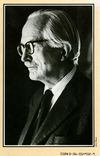Inspector Hazlerigg: Difference between revisions
imported>Hayford Peirce (→Appearances by Hazlerigg: tweaking) |
imported>Hayford Peirce (→In collections of short stories: added a little more info) |
||
| Line 19: | Line 19: | ||
* ''[[Stay of Execution]]'' (1971) — two stories | * ''[[Stay of Execution]]'' (1971) — two stories | ||
* ''Amateur in Violence'' (1973) | * ''Amateur in Violence'' (1973) | ||
* ''[[The Man Who Hated Banks]] '' (1997) — | * ''[[The Man Who Hated Banks]] '' (1997) — seven stories, including one told in the first person; plus a role in a [[Henry Bohun]] story and a mention in another Bohun story | ||
* ''The Curious Conspiracy'' (2002) | * ''The Curious Conspiracy'' (2002) | ||
* ''Even Murderers Take Holidays and Other Mysteries'' (2007) | * ''Even Murderers Take Holidays and Other Mysteries'' (2007) | ||
Revision as of 18:45, 16 September 2016
Inspector Hazlerigg is a police detective created by the British mystery writer Michael Gilbert who appears in six books published between 1947 and 1958, in both novels and numerous short stories. In his first appearance, in the Golden Age mystery novel Close Quarters, which takes place in 1937, Hazlerigg is a Chief Inspector at New Scotland Yard in London. By the final novel in the series, Fear to Tread, he has become a Chief Superintendent. Thirty years before the events in Close Quarters, and before going to London, he had attended a preparatory school of which he now remembers little except that the masters had seemed much happier than the boys. In the short story Modus Operandi we are told that he came to London from Norfolk at the age of 17, which would place his year of birth at 1890. He began by "pounding a beat in Whitechapel." The first time we see him in Close Quarters he is "a thick square man with a brick-red face" and unmarried. A few pages further, after he raises an imaginary gun to his shoulder and fires it, a character thinks that he looks like "a jolly red-faced farmer out for a day's sport". Besides smoking an occasional pipe or Indian cheroot, he has "a heavy jowl and shrewd grey eyes". We are told that he is a mountaineer, with a "fair head for heights". Sitting in his office in Scotland Yard several years later, just after the war, he has a "heavy, Cromwellian face". And in his last appearance in a novel he is:
unmistakably a policeman, although he could also have been a farmer. He was thick set and had a red-brown face and grizzled hair.... Perhaps the only remarkable thing about him was his eyes. They were that shallow grey which, like the grey of the North Sea, can change without warning from friendliness to bleak wrath.
Also in Close Quarters we are told that of his many policeman-like qualities the chief one was "Concentration. Tireless, relentless, implacable concentration.... And yet something more than that. Selective concentration." In Modus Operandi we are told that "his chief asset is that he looks so honest that no one ever attempts to bribe him" and that he has a "shrewd ability to see around corners, which came from his father, who was a poacher." And he has, of course, "a rigid sense of right and wrong."
Appearances by Hazlerigg
In novels
- Close Quarters (1947) — introduction of Chief Inspector Hazlerigg. He first appears on page 74 of the 251-page American edition
- They Never Looked Inside (1948) [U.S. He Didn't Mind Danger (1949)] — He first appears on page 12 of a 191-page British reprint and is still a Chief Inspector
- The Doors Open (1949)
- Smallbone Deceased (1950)
- Death Has Deep Roots (1951)
- Fear to Tread (1953) — short but important role for Chief Superintendent Hazlerigg—he does not appear until page 154 of the 223-page British edition
In collections of short stories
- Stay of Execution (1971) — two stories
- Amateur in Violence (1973)
- The Man Who Hated Banks (1997) — seven stories, including one told in the first person; plus a role in a Henry Bohun story and a mention in another Bohun story
- The Curious Conspiracy (2002)
- Even Murderers Take Holidays and Other Mysteries (2007)
- A Pity about the Girl and Other Stories (2008)
Notes
